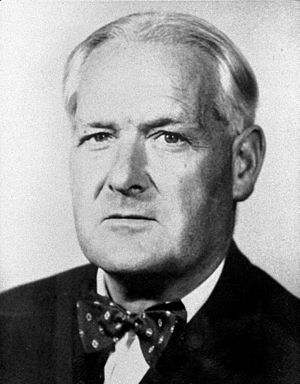Austin Bradford Hill facts for kids
Quick facts for kids
Sir Austin Bradford Hill
|
|
|---|---|
 |
|
| Born | 8 July 1897 Hampstead, London, England
|
| Died | 18 April 1991 (aged 93) Ulverston, Cumbria, England
|
| Nationality | British |
| Occupation | Epidemiologist statistician |
| Known for | "Bradford Hill" criteria |
| Awards | Guy Medal (Gold, 1953) |
Sir Austin Bradford Hill CBE FRS (born July 8, 1897 – died April 18, 1991) was a very important British scientist. He was an epidemiologist, which means he studied how diseases spread and what causes them. He was also a statistician, someone who works with numbers and data.
Sir Austin Bradford Hill is famous for two big things. First, he helped create the idea of a randomized clinical trial. This is a fair way to test if new medicines or treatments really work. Second, he worked with another scientist, Richard Doll, to show a clear link between smoking cigarettes and getting lung cancer. He also developed the "Bradford Hill criteria" to help figure out if something truly causes a disease.
Contents
Early Life and Education
Sir Austin Bradford Hill was born in London, England. His father, Sir Leonard Erskine Hill, was also a famous scientist who studied how the body works. As a child, Austin lived in Loughton, Essex, and went to Chigwell School.
During the First World War, he served as a pilot. However, he became very sick with tuberculosis and had to leave the military. He spent four years recovering in the hospital and at home. Because of this, he couldn't become a doctor. Instead, he studied economics through a special program at London University.
Career and Major Discoveries
Starting in Medical Statistics
In 1922, Hill began working for a group that studied how tiredness affected workers. He met a medical statistician named Major Greenwood. To learn more about statistics, Hill took classes from Karl Pearson, another famous statistician. When Greenwood moved to the new London School of Hygiene and Tropical Medicine, Hill went with him. He became a professor there, teaching about how to use statistics to understand health and disease.
Pioneering Clinical Trials
Sir Austin Bradford Hill had a great career in research and teaching. He also wrote a very popular textbook called Principles of Medical Statistics. But he is most famous for two groundbreaking studies.
One of his biggest achievements was his work on a study about a medicine called streptomycin. This medicine was used to treat tuberculosis. Hill was the statistician for this study. It was one of the first times scientists used a "randomized clinical trial" to test a medicine. In a randomized trial, patients are put into groups by chance. One group gets the new medicine, and another group gets a different treatment or no treatment. This helps scientists see if the new medicine really makes a difference. This idea was first used in farming by Ronald Fisher to test crops.
Linking Smoking to Lung Cancer
Hill's second major work was a series of studies with Richard Doll about smoking and lung cancer.
- First Study (1950): Their first paper looked at people who had lung cancer and compared them to people who didn't. They found a strong connection between smoking and lung cancer.
- Long-Term Study: Doll and Hill then started a "prospective study" of smoking and health. This meant they followed many British doctors (over 40,000 of them!) for many years. They recorded the doctors' smoking habits and their health over time. This study, known as the British doctors study, clearly showed that smoking greatly increased the risk of lung cancer and other diseases.
Some scientists, like Ronald Fisher, disagreed with their findings about smoking and cancer. But Hill and Doll's work was very strong and helped change public health.
Bradford Hill Criteria for Causation
In 1965, Sir Austin Bradford Hill suggested a set of guidelines to help scientists decide if something truly causes a disease. These are known as the "Bradford Hill criteria". They help epidemiologists figure out if a link between an exposure (like smoking) and a disease (like lung cancer) is a real cause-and-effect relationship.
After Hill passed away in 1991, another statistician, Peter Armitage, said that Hill was "quite simply the world's leading medical statistician."
Honours and Awards
Sir Austin Bradford Hill received many awards for his important work:
- From 1950 to 1952, he was the president of the Royal Statistical Society.
- In 1953, he received the Guy Medal in Gold, a very high honour from the Royal Statistical Society.
- In 1954, he became a Fellow of the Royal Society (FRS), which is a group of the most important scientists in the UK.
- He was made a Commander of the Order of the British Empire (CBE) in 1951.
- He was knighted in 1961, which means he received the title "Sir."
See also
 In Spanish: Austin Bradford Hill para niños
In Spanish: Austin Bradford Hill para niños

